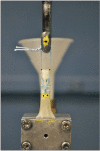Biomechanical Characterization of a New Locking Loop Stitch for Graft Fixation versus Krackow Stitch
- PMID: 37274497
- PMCID: PMC10232308
- DOI: 10.4055/cios22134
Biomechanical Characterization of a New Locking Loop Stitch for Graft Fixation versus Krackow Stitch
Abstract
Background: The purpose of this study was to quantify and compare the biomechanical characteristics of a new locking loop stitch (LLS), developed utilizing the concepts of both running locking stitch and needleless stitch, to the traditional Krackow stitch.
Methods: The Krackow stitch with No.2 braided suture and the LLS with 1.3-mm augmented polyblend suture tape were compared biomechanically. The LLS was performed with single strand locking loops and wrapping suture around the tendon, resulting in half the needle penetrations through the graft compared to the Krackow stitch. Twenty bovine extensor tendons were divided randomly into two groups. The tendons were prepared to match equal thickness and cross-sectional area. Each suture-tendon was stitched and preloaded to 5 N for 60 seconds, cyclically loaded to 20 N, 40 N, and 60 N for 10 cycles each, and then loaded to failure. The deformation of the suture-tendon construct, stiffness, yield load, and ultimate load were measured.
Results: The LLS had significantly less deformation of the suture-tendon construct at 100 N, 200 N, 300 N, and at ultimate load compared to the Krackow stitch (Krackow stitch and LLS at 100 N: 1.3 ± 0.1 mm and 1.0 ± 0.2 mm, p < 0.001; 200 N: 3.0 ± 0.3 mm and 1.9 ± 0.2 mm, p < 0.001; 300 N: 5.1 ± 0.6 mm and 2.9 ± 0.4 mm, p < 0.001; ultimate load: 12.8 ± 2.8 mm and 5.0 ± 1.2 mm, p < 0.001). The LLS had significantly greater stiffness (Krackow stitch and LLS: 97.5 ± 6.9 N/mm and 117.2 ± 13.9 N/mm, p < 0.001) and yield load (Krackow stitch and LLS: 66.2 ± 15.9 N and 237.9 ± 93.6 N, p < 0.001) compared to the Krackow stitch. There was no significant difference in ultimate load (Krackow stitch: 450.2 ± 49.4 N; LLS: 472.6 ± 59.8 N; p = 0.290).
Conclusions: The LLS had significantly smaller deformation of the suture-tendon construct compared to the Krackow stitch. The LLS may be a viable surgical alternative to the Krackow stitch for graft fixation when secure fixation is necessary.
Keywords: Biomechanics; Graft; Krackow; Locking loop.
Copyright © 2023 by The Korean Orthopaedic Association.
Conflict of interest statement
CONFLICT OF INTEREST: This study was partially funded by Arthrex, Inc., which provided the specimens and surgical implants for this study. The funding sources did not play any role in the design of the study or the evaluation or reporting of data.
Figures




References
-
- Jassem M, Rose AT, Meister K, Indelicato PA, Wheeler D. Biomechanical analysis of the effect of varying suture pitch in tendon graft fixation. Am J Sports Med. 2001;29(6):734–737. - PubMed
-
- Krackow KA, Thomas SC, Jones LC. A new stitch for ligament-tendon fixation. Brief note. J Bone Joint Surg Am. 1986;68(5):764–766. - PubMed
-
- Hahn JM, Inceoglu S, Wongworawat MD. Biomechanical comparison of Krackow locking stitch versus nonlocking loop stitch with varying number of throws. Am J Sports Med. 2014;42(12):3003–3008. - PubMed
-
- Hong CK, Yeh ML, Jou IM, Lin CL, Chang CH, Su WR. Evaluation of 3 needleless grasping suture techniques for soft-tissue graft fixation: a porcine biomechanical study. Arthroscopy. 2015;31(6):1151–1155. - PubMed
MeSH terms
LinkOut - more resources
Full Text Sources

